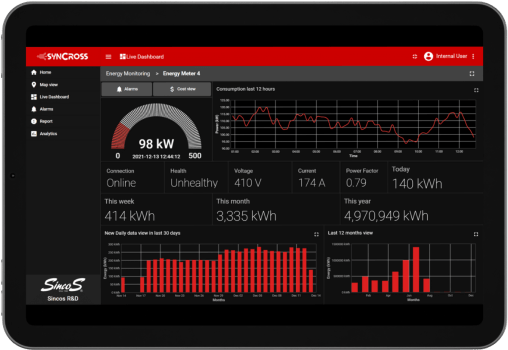An energy management system gives an in-depth insight into a manufacturing unit’s energy consumption, analyses machines’ power efficiency, and identifies wastages. Operators can determine sudden changes in the energy requirement. Industrial IoT sensors and systems are used to collect energy consumption data that are analyzed to make better decisions, reduce downtime, and prevent malfunction by taking proactive measures that help businesses reduce their operational cost.
Difficulties Faced By Manufacturers
Before the emergence of Industry 3.0, energy management was one of the biggest challenges for industrialists. Since there weren’t any effective means for identifying the amount of energy used within a system, businesses had to face huge losses in performance and efficiency. Industries had to rely on the workforce to manually inspect all the different systems and identify where the issues were. As you can imagine, this was not a viable solution.
When Industry 3.0 brought in computerization techniques, manufacturers were glad that they finally had a proper energy monitoring system. Unfortunately, even with SCADA and PLCs in place, there was one challenge companies couldn’t overcome: real-time monitoring. Although these new systems allowed manufacturers to automate the energy monitoring process, manufacturers realized that they were receiving vital information after the fact.
Luckily, engineering companies were quick to realize this issue and developed a solution. By utilizing the power of IIoT, factories could monitor real-time energy consumption as well as identify trends and patterns through the use of historical data. This allowed industries to have more control over the manufacturing process as they could now pinpoint all the possible bottlenecks that may occur even before they become an issue.
What Are The Benefits Of Using An Industrial IoT-Based EMS?
IoT becomes a powerful tool when used in conjunction with an EMS. It offers an array of benefits that goes beyond just the energy power supply chain. Here is a brief overview.
Reduce Energy Consumption
The most prominent advantage of an IIoT EMS is the ability to reduce power consumption. As manufacturers can monitor how much power is being used in real-time, forecast data can be used to optimize the whole process and reduce energy wastage.
Comply With Regulations
In tandem with the previous point, the real-time capabilities of this system allow manufacturers to reduce their carbon footprint. Up-to-date analytics of all daily activities helps manufacturers to see if they are within regulation limits.
Integration With Green Energy
EMS opens up the border for industries to utilize green energy. They are now able to monitor performance and develop a better understanding of how to best maximize the potential of renewable energy.
Preventive Actions
The predictive algorithms of EMS help to identify potential malfunctions before they happen. This allows manufacturers to take preventive actions instead of having to deal with them after the damage has already been done.
Improves Accident Management
In a scenario where an accident or error has already occurred, EMS can come in handy in these situations as well. The sensors can locate, identify, and record the problem and instantaneously send the data to the operator so that they can make on-spot decisions about what to do.
Predicting Consumption And Spending
Manufacturers can use the analytical features of an IIoT EMS to determine how much energy is required on a day-to-day basis. In addition, machine learning algorithms can predict future energy consumption requirements. These insights will help the manufacturer to develop spending strategies based on accurate data.
Introducing SynCross: Your One-stop Solution For Energy Monitoring

Technology is advancing at an exponential rate all across the world. And this is true for Bangladesh as well, especially in the manufacturing industry. Smart machines and AI are becoming the norm. However, one of the most important breakthroughs in technology is the Internet of Things (IoT). It is an umbrella term for a system of devices that can communicate with each other using the internet.
Syncross, one of the leading industrial automation solution providers, has developed an energy management system based on the Industrial Internet of Things (IIoT) called SynCross. This system will enable manufacturers to have in-depth insights into their production lines, machine efficiency, human resource efficiency, and wastages. Furthermore, SynCross EMS can also monitor utilities like gas, water, steam, electricity, etc., and determine how much of it is being used in different lines, zones, and sectors of the plant. Here is a quick overview of some of the most prominent features of SynCross.
- Real-time energy consumption tracking.
- Cross-compatible with virtually any device.
- Non-intrusive data capture.
- Advanced data analysis, interpretation, and visualization.
- Enterprise-grade data security.
- API for direct MES or ERP integration.
- Secure access from anywhere in the world and with any device (PC/smartphone/tablet).
- Interoperable between machines and systems.
- No software installation is required.
- Cloud server storage availability.
- Dashboard and system architecture are completely customizable as per the user’s requirement.
- Users can access any data point from Map view and gather the analytics from there.
- Report generation in various formats such as pdf or excel, including the time duration.
- Data monitoring in real-time with alarm, fault, and other statuses.
Benefits Of Using SynCross
Artificial intelligence is baked into the SynCross IIoT ecosystem, which allows for auto-diagnostics features, streamlines logistics, increases occupational safety, and achieves higher overall efficiency across the board. Below, we have outlined all the benefits of using SynCross.
Predictive maintenance scheduling: Utilize the capability of AI and machine learning to understand how SynCross IIoT-connected assets are trending and spend less time manually scheduling maintenance or monitoring assets.
Early detection: Leverage forecasts to predict when your assets will need maintenance before they break down or fail in the field.
Resource planning: Identify opportunities to streamline production processes and asset performance in the field, thus ultimately designing improved products faster.
Quality control: Instantaneous response to the slightest material degradation could all but eliminate costly downtime due to equipment failure. SynCross IIoT enables better quality control with advanced vision systems.
Entire supply chain management: AI and IIoT sensors have a large part to play in developing a more robust and resilient supply chain management system with enhanced asset tracking and efficiencies.
Is SynCross A Better Implementation Than Traditional SCADA?
To put it briefly, SynCross has certain benefits that trump traditional SCADA systems in a few key areas. They are:
Capability: One of the biggest advantages SynCross has over traditional SCADA systems is that it is composed of a fully connected ecosystem.
Data-driven approach: The SynCross IIoT ecosystem is being widely adopted in the industry thanks to its sensor-based technology and data-driven approach.
Better decision making: The IIoT dashboard of SynCross enables manufacturers to strategize their business decisions and improve upon the loopholes to serve with better quality.
Convenience: SynCross can be deployed practically in any situation unlike SCADA to achieve deeper, more detailed, and easy-to-use results. Moreover, its ecosystem doesn’t require an existing SCADA or PLC-based system to be implemented.
Data insights: Data collected using the power and scalability of IIoT can be used for a variety of purposes, such as increasing productivity, reducing costs, and improving product quality. Syncross IIoT outshines all of its competitors in this field.
Why Should You Use SynCross?
SincoS has extensive experience in the field of industrial automation. SynCross is a culmination of the company’s 35+ years of expertise and intuitive problem-solving skills. It is an innovative monitoring system that has immense potential to be deployed in various industries. Currently, SynCross IIoT has already been adopted by several conglomerates like British American Tobacco, Dhaka WASA, Abul Khair Group, Mainetti Packaging Pvt. Ltd. And Sincos is working with other well-known brands to further improve the production capabilities of our country.

